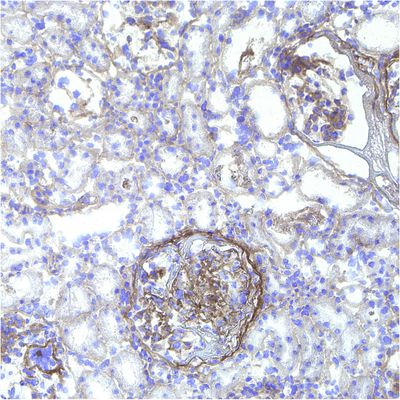

- Home
- Companies
- 3Helix Inc
- Products
- 3Helix - Model B-CHP - Collagen ...

3Helix - Model B-CHP - Collagen Hybridizing Peptide, Biotin Conjugate
The collagen hybridizing peptide (CHP) is a novel and unique peptide that specifically binds unfolded collagen chains, both in vitro and in vivo.[1,2,3] By sharing the Gly-X-Y repeating sequence of natural collagen, CHP has a strong capability to hybridize with denatured collagen chains by reforming the triple helical structure, in a fashion similar to DNA fragments annealing to complementary DNA strands. CHP is extremely specific: it has negligible affinity to intact collagen molecules due to lack of binding sites, and it is inert towards non-specific binding because of its neutral and hydrophilic nature.
CHP is a powerful histopathology tool which enables straightforward detection of inflammation and tissue damage caused by a large variety of diseases, as well as tissue remodeling during development and aging.[3] CHP robustly visualizes the pericellular matrix turnover caused by proteolytic migration of cancer cells within 3D collagen culture, without the use of synthetic fluorogenic matrices or genetically modified cells.[4] CHP can measure and localize mechanical injury to collagenous tissue at the molecular level.[5] It also enables assessment of collagen denaturation in decellularized extracellular matrix.[6] In addition, CHP can be used to specifically visualize collagen bands in SDS-PAGE gels without the need for western blot.[7]
B-CHP is labeled with biotin for avidin/streptavidin-mediated detection. B-CHP offers flexible detection options, such as non-green fluorescence and HRP-enzyme methods, to avoid background and enhance signal.
Specificity: CHP binds to the unfolded triple-helical chains of all collagen types (e.g., I, II, III, IV, etc).[3,7]
Applications: immunofluorescence,[3] immunohistochemistry[3]
B-CHP provides the flexibility for visualizing damaged collagen using any user-selected fluorophore (e.g., AlexaFluor dyes conjugated streptavidin), or a non-fluorescence method (e.g., through NeutrAvidin-HRP mediated DAB staining).
In addition, B-CHP and commercial streptavidin-conjugated gold nanoparticles can be used in combination to label unfolded collagen molecules under TEM: collagen fibers in an intact or mechanically overloaded rat tail tendon probed by B-CHP and streptavidin conjugated 10nm-sized gold nanoparticles (scale bar: 200 nm).
- Synonyms : B-CHP, collagen mimetic peptide (CMP)
- Molecular weight : 2762.01 g/mol
- Purity : 95% by HPLC
- Conjugate : Single biotin tag per peptide
- Content : Purified lyophilized powder
- Storage : -20 °C as powder, 4 °C after reconstitution in water
- More informative, reliable and convenient than zymography, DQ collagen, SHG, and TEM
- High affinity and unparalleled specificity to collagen with essentially no nonspecific binding
- Applicable to all types of collagen from all species, relying on collagen`s secondary structure instead of any defined sequence for binding
- Suitable for both frozen and paraffin-embedded sections with no need for antigen retrieval
- A non-antibody approach with no species restrictions against any co-staining antibody
- Small size (2% of IgG by MW) enabling facile tissue penetration and whole specimen staining without sectioning
- Stable in solution under 4 °C, eliminating the need to aliquot for storage
B-CHP provides the flexibility for visualizing damaged collagen using any user-selected fluorophore (e.g., AlexaFluor dyes conjugated streptavidin), or a non-fluorescence method (e.g., through NeutrAvidin-HRP mediated DAB staining).
In addition, B-CHP and commercial streptavidin-conjugated gold nanoparticles can be used in combination to label unfolded collagen molecules under TEM: collagen fibers in an intact or mechanically overloaded rat tail tendon probed by B-CHP and streptavidin conjugated 10nm-sized gold nanoparticles (scale bar: 200 nm).
